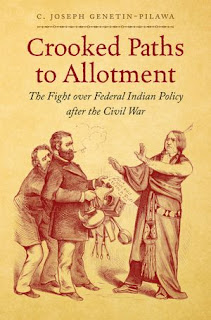
He applied the “Page 99 Test” to his new book, Crooked Paths to Allotment: The Fight over Federal Indian Policy after the Civil War, and reported the following:
Jumping in to page 99 of my book places readers directly into the heart of the conflicts and contestations that drive Crooked Paths to Allotment. On a basic level, it is a book about the politics of federal Native policymaking following the Civil War. In particular, I seek to interrogate the standard historical narrative that views the nineteenth century in terms of steadily declining Indigenous sovereignty, from removal of southeastern tribes to the 1887 General Allotment Act. I argue that at several particular moments in the mid- to late nineteenth century, Native American reformers and their white allies challenged coercive practices and offered visions for policies that might have allowed Indigenous nations to adapt at their own pace and on their own terms.Learn more about Crooked Paths to Allotment at the University of North Carolina Press website.
The Reconstruction period was especially important because it was a time when white Americans emerged from the Civil War searching for meaning out of their recent traumas and sacrifices and were willing to consider, at least initially, a drastically reconfigured nation that would be fundamentally more inclusive. These moments, though, also illuminate the strength and pervasiveness of American settler colonial thought as state actors consolidated or reconsolidated political power and repressed alternative pathways, and that’s what I’m discussing on page 99. It falls in the middle of a chapter called “A Contentious Peace Policy, 1871-1875” that charts the efforts of mainstream assimilationists (especially the Board of Indian Commissioners and a Philadelphia merchant named William Welsh) to repress the policy alternatives championed by Native activists (such as Ely S. Parker, a Tonawanda Seneca and the first Commissioner of Indian Affairs who was Indigenous himself). Here are the two full paragraphs on the page:
The BIC [Board of Indian Commissioners] could have provided transparency and public oversight of the policy-making process. It did not. Instead, it sought to limit public access to Indian policy, while placing it in the hands of a small circle of respected white elites who shared similar religious, business, and social interests. When the OIA [Office of Indian Affairs] drafted its communications with contractors in 1871, the BIC sought to signify its (perceived) superior position by adding “under the supervision of the Board of Indian Commissioners.” Welsh and the BIC campaigned against and successfully removed federal officials who did not agree with their positions: first Ely Parker and then his successor, E.P. Smith, and Secretary of the Interior Columbus Delano. Most significantly, in 1874, the BIC proposed to separate the OIA from the Interior Department and establish it as an independent, executive-level agency. They argued that this would protect it against political patronage, a broader Reconstruction-era issue that had become a rallying-cry for disaffected Democrats and reform-minded Republicans in the Republican-dominated years of the Grant administration. But their proposal also bore the marks of an effort to control access to the mechanisms of political power. Ultimately, it failed, and in response, six of the original members resigned en masse.Although there are other historiographic contributions I attempt to make throughout, the material summarized on page 99 is an accurate reflection of what the book does. It’s a story of paths that might have been taken in Indian policy, but were not. These paragraphs also represent my effort to connect developments in Indian Affairs to the larger context of the Reconstruction Era and in so doing, to suggest that any attempt to make sense of late-nineteenth-century US history has to take seriously Indigenous histories and experiences.
Prior to this development, in the years between 1869-1874, Welsh and the BIC established a policy framework that at its foundation held a belief in Indian confinement and assimilation by any means necessary, animated by an expressly elitist, evangelical Christian approach to policy making. Advancing their agenda between 1869 and 1874, these reformers effectively derailed any progress Parker and his compatriots had made in developing an alternative agenda. Indeed, their programs helped cement, for the next several generations at least, the notion that non-Native people understood the best interests of Native communities and the idea that the federal government could, in a short period of time, destroy Indian autonomy and distinct Indigenous communities for the betterment of Indian people and the United States.
--Marshal Zeringue



